Qiannan Zhu
Beyond Models! Explainable Data Valuation and Metric Adaption for Recommendation
Feb 12, 2025Abstract:User behavior records serve as the foundation for recommender systems. While the behavior data exhibits ease of acquisition, it often suffers from varying quality. Current methods employ data valuation to discern high-quality data from low-quality data. However, they tend to employ black-box design, lacking transparency and interpretability. Besides, they are typically tailored to specific evaluation metrics, leading to limited generality across various tasks. To overcome these issues, we propose an explainable and versatile framework DVR which can enhance the efficiency of data utilization tailored to any requirements of the model architectures and evaluation metrics. For explainable data valuation, a data valuator is presented to evaluate the data quality via calculating its Shapley value from the game-theoretic perspective, ensuring robust mathematical properties and reliability. In order to accommodate various evaluation metrics, including differentiable and non-differentiable ones, a metric adapter is devised based on reinforcement learning, where a metric is treated as the reinforcement reward that guides model optimization. Extensive experiments conducted on various benchmarks verify that our framework can improve the performance of current recommendation algorithms on various metrics including ranking accuracy, diversity, and fairness. Specifically, our framework achieves up to 34.7\% improvements over existing methods in terms of representative NDCG metric. The code is available at https://github.com/renqii/DVR.
Cognitive Personalized Search Integrating Large Language Models with an Efficient Memory Mechanism
Feb 16, 2024



Abstract:Traditional search engines usually provide identical search results for all users, overlooking individual preferences. To counter this limitation, personalized search has been developed to re-rank results based on user preferences derived from query logs. Deep learning-based personalized search methods have shown promise, but they rely heavily on abundant training data, making them susceptible to data sparsity challenges. This paper proposes a Cognitive Personalized Search (CoPS) model, which integrates Large Language Models (LLMs) with a cognitive memory mechanism inspired by human cognition. CoPS employs LLMs to enhance user modeling and user search experience. The cognitive memory mechanism comprises sensory memory for quick sensory responses, working memory for sophisticated cognitive responses, and long-term memory for storing historical interactions. CoPS handles new queries using a three-step approach: identifying re-finding behaviors, constructing user profiles with relevant historical information, and ranking documents based on personalized query intent. Experiments show that CoPS outperforms baseline models in zero-shot scenarios.
CMMU: A Benchmark for Chinese Multi-modal Multi-type Question Understanding and Reasoning
Jan 26, 2024



Abstract:Multi-modal large language models(MLLMs) have achieved remarkable progress and demonstrated powerful knowledge comprehension and reasoning abilities. However, the mastery of domain-specific knowledge, which is essential for evaluating the intelligence of MLLMs, continues to be a challenge. Current multi-modal benchmarks for domain-specific knowledge concentrate on multiple-choice questions and are predominantly available in English, which imposes limitations on the comprehensiveness of the evaluation. To this end, we introduce CMMU, a novel benchmark for multi-modal and multi-type question understanding and reasoning in Chinese. CMMU consists of 3,603 questions in 7 subjects, covering knowledge from primary to high school. The questions can be categorized into 3 types: multiple-choice, multiple-response, and fill-in-the-blank, bringing greater challenges to MLLMs. In addition, we propose a rigorous evaluation strategy called ShiftCheck for assessing multiple-choice questions. The strategy aims to reduce position bias, minimize the influence of randomness on correctness, and perform a quantitative analysis of position bias. We evaluate seven open-source MLLMs along with GPT4-V, Gemini-Pro, and Qwen-VL-Plus. The results demonstrate that CMMU poses a significant challenge to the recent MLLMs.
Learning Explicit User Interest Boundary for Recommendation
Nov 22, 2021



Abstract:The core objective of modelling recommender systems from implicit feedback is to maximize the positive sample score $s_p$ and minimize the negative sample score $s_n$, which can usually be summarized into two paradigms: the pointwise and the pairwise. The pointwise approaches fit each sample with its label individually, which is flexible in weighting and sampling on instance-level but ignores the inherent ranking property. By qualitatively minimizing the relative score $s_n - s_p$, the pairwise approaches capture the ranking of samples naturally but suffer from training efficiency. Additionally, both approaches are hard to explicitly provide a personalized decision boundary to determine if users are interested in items unseen. To address those issues, we innovatively introduce an auxiliary score $b_u$ for each user to represent the User Interest Boundary(UIB) and individually penalize samples that cross the boundary with pairwise paradigms, i.e., the positive samples whose score is lower than $b_u$ and the negative samples whose score is higher than $b_u$. In this way, our approach successfully achieves a hybrid loss of the pointwise and the pairwise to combine the advantages of both. Analytically, we show that our approach can provide a personalized decision boundary and significantly improve the training efficiency without any special sampling strategy. Extensive results show that our approach achieves significant improvements on not only the classical pointwise or pairwise models but also state-of-the-art models with complex loss function and complicated feature encoding.
Is There More Pattern in Knowledge Graph? Exploring Proximity Pattern for Knowledge Graph Embedding
Oct 02, 2021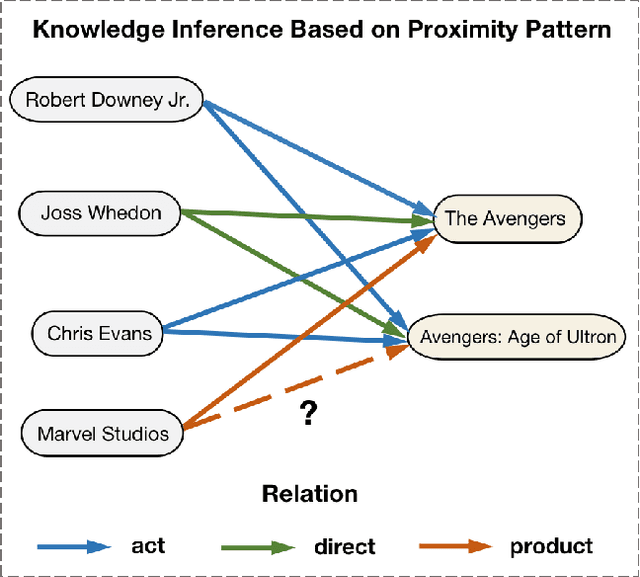
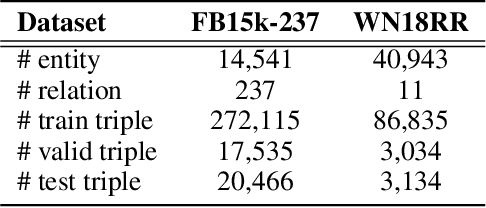
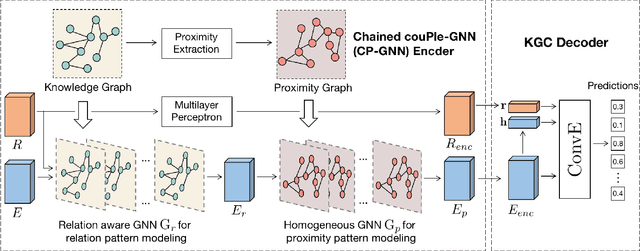
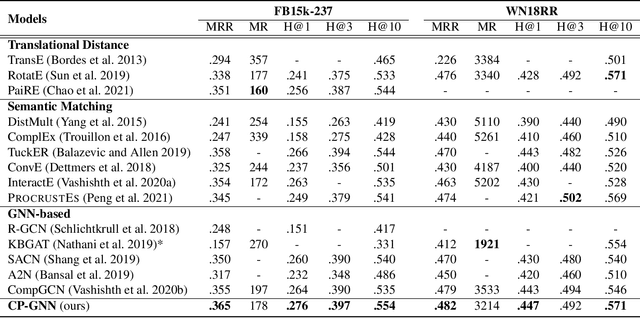
Abstract:Modeling of relation pattern is the core focus of previous Knowledge Graph Embedding works, which represents how one entity is related to another semantically by some explicit relation. However, there is a more natural and intuitive relevancy among entities being always ignored, which is that how one entity is close to another semantically, without the consideration of any explicit relation. We name such semantic phenomenon in knowledge graph as proximity pattern. In this work, we explore the problem of how to define and represent proximity pattern, and how it can be utilized to help knowledge graph embedding. Firstly, we define the proximity of any two entities according to their statistically shared queries, then we construct a derived graph structure and represent the proximity pattern from global view. Moreover, with the original knowledge graph, we design a Chained couPle-GNN (CP-GNN) architecture to deeply merge the two patterns (graphs) together, which can encode a more comprehensive knowledge embedding. Being evaluated on FB15k-237 and WN18RR datasets, CP-GNN achieves state-of-the-art results for Knowledge Graph Completion task, and can especially boost the modeling capacity for complex queries that contain multiple answer entities, proving the effectiveness of introduced proximity pattern.
How Does Knowledge Graph Embedding Extrapolate to Unseen Data: a Semantic Evidence View
Sep 24, 2021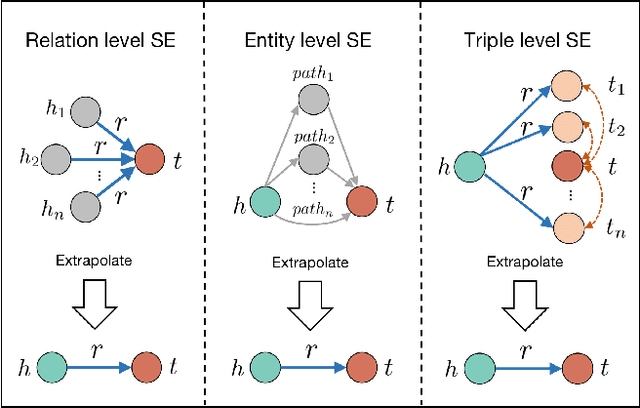
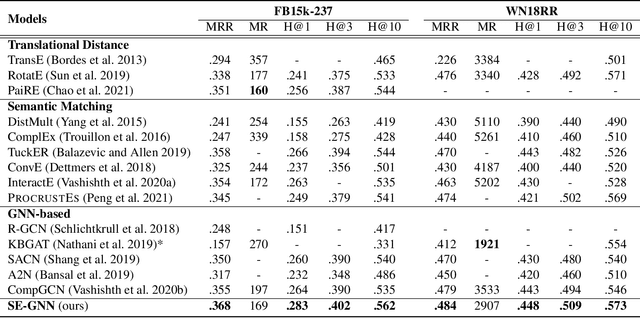
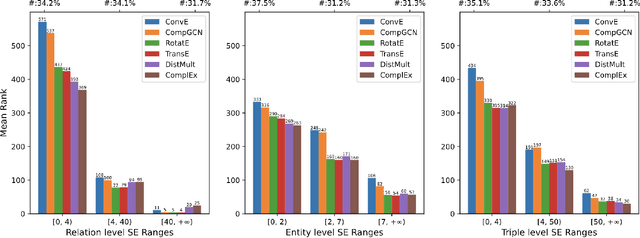
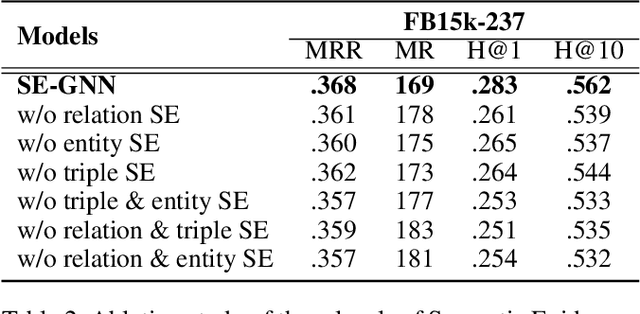
Abstract:Knowledge Graph Embedding (KGE) aims to learn representations for entities and relations. Most KGE models have gained great success, especially on extrapolation scenarios. Specifically, given an unseen triple (h, r, t), a trained model can still correctly predict t from (h, r, ?), or h from (?, r, t), such extrapolation ability is impressive. However, most existing KGE works focus on the design of delicate triple modeling function, which mainly tell us how to measure the plausibility of observed triples, but we have limited understanding of why the methods can extrapolate to unseen data, and what are the important factors to help KGE extrapolate. Therefore in this work, we attempt to, from a data relevant view, study KGE extrapolation of two problems: 1. How does KGE extrapolate to unseen data? 2. How to design the KGE model with better extrapolation ability? For the problem 1, we first discuss the impact factors for extrapolation and from relation, entity and triple level respectively, propose three Semantic Evidences (SEs), which can be observed from training set and provide important semantic information for extrapolation to unseen data. Then we verify the effectiveness of SEs through extensive experiments on several typical KGE methods, and demonstrate that SEs serve as an important role for understanding the extrapolation ability of KGE. For the problem 2, to make better use of the SE information for more extrapolative knowledge representation, we propose a novel GNN-based KGE model, called Semantic Evidence aware Graph Neural Network (SE-GNN). Finally, through extensive experiments on FB15k-237 and WN18RR datasets, we show that SE-GNN achieves state-of-the-art performance on Knowledge Graph Completion task and perform a better extrapolation ability.
 Add to Chrome
Add to Chrome Add to Firefox
Add to Firefox Add to Edge
Add to Edge